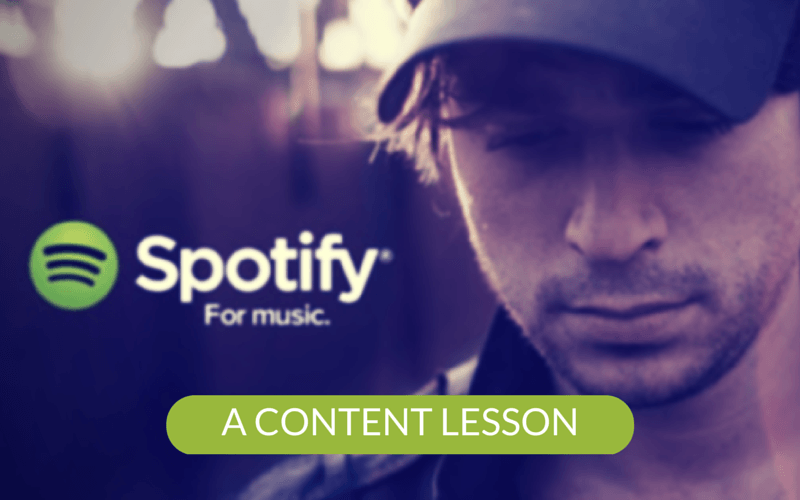The music streaming service Spotify can teach content marketing professionals a number of things which can improve how our content is organized and distributed. Here they are.
A few years back, when I was a student, I had an idea with a friend of mine, who is a music freak like me. We discussed the idea that there should be a music discovery service that should enable listeners to discover music based on moods, not on genres. Sometimes you want to get out of the genres and artists you already know and you want to discover something new or just set a mood… But if you’re a metal-afficionado, you’re going to have a hard time trying to find the right „chill“ music…
So the idea was to create an interface which would give you a choice based on mood or situation instead of genre or artist.
- Moods: Sad, melancholic, relaxed, romantic, depressed, happy etc.
- Situations: Travel to a specific destination, party, working out etc.
Basically the idea was to match the music to the experience in order to enhance it.
Fast forward a few years.
I’ve been a paying Spotify Subscriber (Premium) for something like a year and a half now. The fact that you can access over 20 million songs and save them for offline listening convinced me as soon as I learned about the platform. Playlists kind of worked for me with regard to the idea I had with my friend. However, one day (I don’t know when that was precisely) Spotify introduced an interface allowing you to discover music different means. And I absolutely loved it.

Notice how Spotify sorts the music? There are genres yes, but also moods. If you dig further into the different options you will see a wide array of different themes & topics curated into playlists.
I think Spotify can inspire us (content marketers) in 3 ways.
1 – Content is an experience
What I like about how Spotify organized the way music fans browse through music (content) is the fact that the Swedish company obviously understood the experiential value of music (if you are interested in the subject, you might want to download my master’s thesis).
In their book The 7th era of marketing, Robert Rose and Carla Johnson write that Marketing is more and more about creating value rather than just describing it.
„The idea of providing education, delight and general usefulness provides a new way to enrich interactions with customers at every stage of the buying journey.“
Like Spotify you should acknowledge the experiential and benefits your audience sees in your content – or the benefits you want them to perceive. Think about what motivates people to come back to your content hub and what underlying benefits they see in your content. That should be part of your content marketing strategy.
[bctt tweet=“Content isn’t just content. It’s part of an experience.“ username=“MaelRoth“]
For example: if you visit the hubspot blog, it’s because it delivers value through practical tips on inbound marketing but what motivates peoples to come back is also the fact that they feel part of a „movement“, they are part of the marketing revolution – a message Hubspot spreads time and time again on events.
2 – Think about how Content gets discovered
If you are producing content, you have to think about how it will be delivered and discovered by the people you are trying to reach (or should I say help?). Maybe it’s time to rethink how you deliver your content?
Building on the point I made above, can you think of other ways your content could find its way to your audience? Do you deliver what people expect on each channel? Many marketers see channels as pipelines through which they can fire content in the right format at their audience. However it’s not necessarily about the format (audio, video, picture, text), it’s about the „why“ people should care.
[bctt tweet=“#ContentMarketing – It’s not about the format, it’s about people sharing an experience“ username=“MaelRoth“]
If Spotify just worried about formats, they’d still be categorizing music in Rock, Classic, Hip-Hop and Country. What they did instead is to curate it by searching to understand the „why“ behind content discovery instead of focusing on the „what“.
3 – Outstanding curation can be a competitive advantage
When I wrote a post on why and how to curate content on the German Hubspot Blog I wrote: „Is Content really King? Or just when you publish it?“
Content Curation is often undervalued and that’s a shame.
Spotify doesn’t produce music itself (or does it?) but curates content. As I wrote above, they do an excellent job with this by acknowledging the experiential value. Actually curation can be seen as their core business and it is what made them so big.
Why should it inspire you?
Don’t just blast out your own content but find the best content on the web and share it with your followers as well. Many times I’ve read about the different theories for the perfect curation ratio (30 / 60 / 10, 10 / 4 / 1, 80% / 20% etc.) and I’d recommend you use it as an indicator, but don’t limit yourself to a stupid ratio.
[Tweet „Don’t limit yourself with a stupid ratio. Great content? Share it!“]
When I find great content I share it and if I think it did not get the attention it deserves, I share it again later, even though it’s not mine! This is how you build a brand based on being interesting and helpful rather than self-promotional… And isn’t this the underlying principle behind Content Marketing / Inbound Marketing?
What do you think about my lessons Spotify can teach us? Can you think of other ones? I’d love to continue the discussion in the comments or on social!



